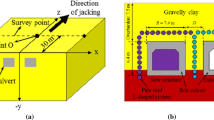Abstract
The total electric field on the roof platform of buildings becomes a new and important indicator of the environmental assessment of HVDC projects. In this paper, the upper-stream finite element method is used to simulate and calculate the distribution characteristics of the total electric field on the roof platform of the flat-roofed building adjacent to an HVDC line, from the factors of material conductivity and three-dimensional structure. The results show that when the conductivity of the building is greater than 10−10 S/m, it can be regarded as an equipotential body with the ground. Therefore, when the field mill measures the electric field on the roof platform, the field mill can be connected to the building to achieve the purpose of grounding. Otherwise, additional appropriate grounding treatment is required. Moreover, the protrusions such as parapets and stairwells on the roof platform of the building have both distortion and shielding effects on the total electric field. The larger the area of the protrusions, the better the shielding effect, making the total electric field on the roof platform weaker. Therefore, when measuring the total electric field on the roof platform, to avoid the unpredictability of the measurement results of the field mill, the field mill should be arranged in the center flat area at least 2 m away from the protrusions.








Similar content being viewed by others

Abbreviations
- HVDC:
-
High-voltage direct current transmission
- \(\varphi_{{\text{a}}}\) :
-
Potential in the air domain
- \(\varphi_{{\text{c}}}\) :
-
Potential in the building domain
- \(\varepsilon_{0}\) :
-
The dielectric constant of air
- \(\rho_{ + }\) :
-
The density of positive particles
- \(\rho_{ - }\) :
-
The density of negative particles
- \(\rho_{{\text{s}}}\) :
-
The accumulated charge density at the interface between the air domain and the building domain
- \({\varvec{E}}_{{\text{a}}}\) :
-
The vector of the electric field strength in air domain
- \({\varvec{E}}_{{\text{b}}}\) :
-
The vector of the electrostatic field strength in building domain
- \({\varvec{J}}_{ + }\) :
-
The ion flow density vectors formed by positive particles
- \({\varvec{J}}_{ - }\) :
-
The ion flow density vectors formed by negative particles
- \(k_{ + }\) :
-
The mobility of positive particles
- \(k_{ - }\) :
-
The mobility of negative particles
- \({\varvec{W}}\) :
-
The wind speed vector
- \(R_{ + }\) :
-
The recombination coefficients of positive particles
- \(R_{ - }\) :
-
The recombination coefficients of negative particles
- \(e\) :
-
The charge per electron
- \({\varvec{e}}_{{\text{n}}}\) :
-
The unit normal vector
- \({\varvec{J}}_{{\text{a}}}\) :
-
The current density vector of the ion flow field
- \({\varvec{J}}_{{\text{b}}}\) :
-
The current density vector of the electrostatic field
- \(\gamma_{{\text{a}}}\) :
-
The equivalent conductivity of the air
- \(\gamma_{{\text{b}}}\) :
-
The conductivity of the building
- \(\lambda\) :
-
The correction factor \(0 \le \lambda \le 1\)
References
Wang Y, Zhang J, Gan Z, Xu J (2021) Simulations and experiments of the generation apparatus of the DC electric field with the space charge[J]. High Voltage 6(6):1061–1068. https://doi.org/10.1049/hve2.12099
Maruvada PS, Dallaire RD, Pedneault R (1983) Development of field-mill instruments for ground-level and above-ground electric field measurement under HVDC transmission lines[J]. IEEE Transactions Power Apparatus Syst. https://doi.org/10.1109/TPAS.1983.318035
GB 39220–2020 Limits and monitoring methods of total electric field of DC transmission project[S] 2020–12–01
Kasdia A, Zebboudj Y, Yala H (2017) Calculation and measurement of electric field under HVDC transmission lines[J]. Eur Phys J Appl Phys 37:323–329. https://doi.org/10.1051/epjap:2007026
IEEE Std 1227–1990 IEEE guide for the measurement of DC electric-field strength and ion related quantities[S] 1990–11–30. DOI: https://doi.org/10.1109/IEEESTD.1990.101059.
Zhen Y, Cui X, Luo Z, Lu T, Lu J, Yang Y, Liu Y, Han H, Ju Y (2011) FEM for 3D total electric field calculation near HVDC lines[J]. Transactions China Electrotech Soc 26(4):153–160. https://doi.org/10.19595/j.cnki.1000-6753.tces.2011.04.023
Zhen Y, Cui X, Lu T (2014) Modeling of an ionized electric field on the building near the UHVDC transmission lines[J]. Sci China Technol Sci 57(4):747–753. https://doi.org/10.1007/s11431-014-5490-8
Wang D, Lu T, Li Q, Chen B, Li X (2017) 3-D electric field computation of steeple rooftop houses near HVDC transmission lines[J]. IEEE Trans Magn 53(6):7205704. https://doi.org/10.1109/TMAG.2017.2666547
Takuma T, Ikeda T, Kawamoto T (1981) Calculation of ion flow fields of HVDC transmission lines by the finite element method[J]. IEEE Transactions Power Apparatus Syst. https://doi.org/10.1109/TPAS.1981.316432
Zhang B, Mo J, Liu J (2020) Calculation of ion flow fields of HVDC transmission lines by coupling flux tracing method with finite element method[C].In: 2020 IEEE international conference on high voltage engineering and application (ICHVE), pp 20276677, 06–10 September 2020, Beijing, China, DOI: https://doi.org/10.1109/ICHVE49031.2020.9280076
Janischewskyj W, Cela G (1979) Finite element solution for electric fields of coronating DC transmission lines[J]. IEEE Transactions Power Apparatus Syst. https://doi.org/10.1109/TPAS.1979.319258
Funding
This study is supported by the Science and Technology Foundation of State Grid Corporation of China (Grant No. 5500-202155496A-0–5-ZN).
Author information
Authors and Affiliations
Contributions
ZL wrote the main manuscript text. JX, ZL, YW, and ZG put forward the methodology and made a preliminary analysis. BW, ZG, and YL provided technical guidance and funding acquisition. BW provided conceptualization, resources, and supervision. JX, ZL, and Ni Li prepared the figures. TL and YL verified the manuscript. All authors reviewed the manuscript.
Corresponding author
Ethics declarations
Conflict of interest
The authors declare no competing interests.
Additional information
Publisher's Note
Springer Nature remains neutral with regard to jurisdictional claims in published maps and institutional affiliations.
Rights and permissions
Springer Nature or its licensor (e.g. a society or other partner) holds exclusive rights to this article under a publishing agreement with the author(s) or other rightsholder(s); author self-archiving of the accepted manuscript version of this article is solely governed by the terms of such publishing agreement and applicable law.
About this article
Cite this article
Liao, Z., Xu, J., Wan, B. et al. Finite element analysis of total electric field distribution on the roof of flat-roofed buildings near HVDC lines. Electr Eng 105, 1153–1162 (2023). https://doi.org/10.1007/s00202-022-01722-1
Received:
Accepted:
Published:
Issue Date:
DOI: https://doi.org/10.1007/s00202-022-01722-1



